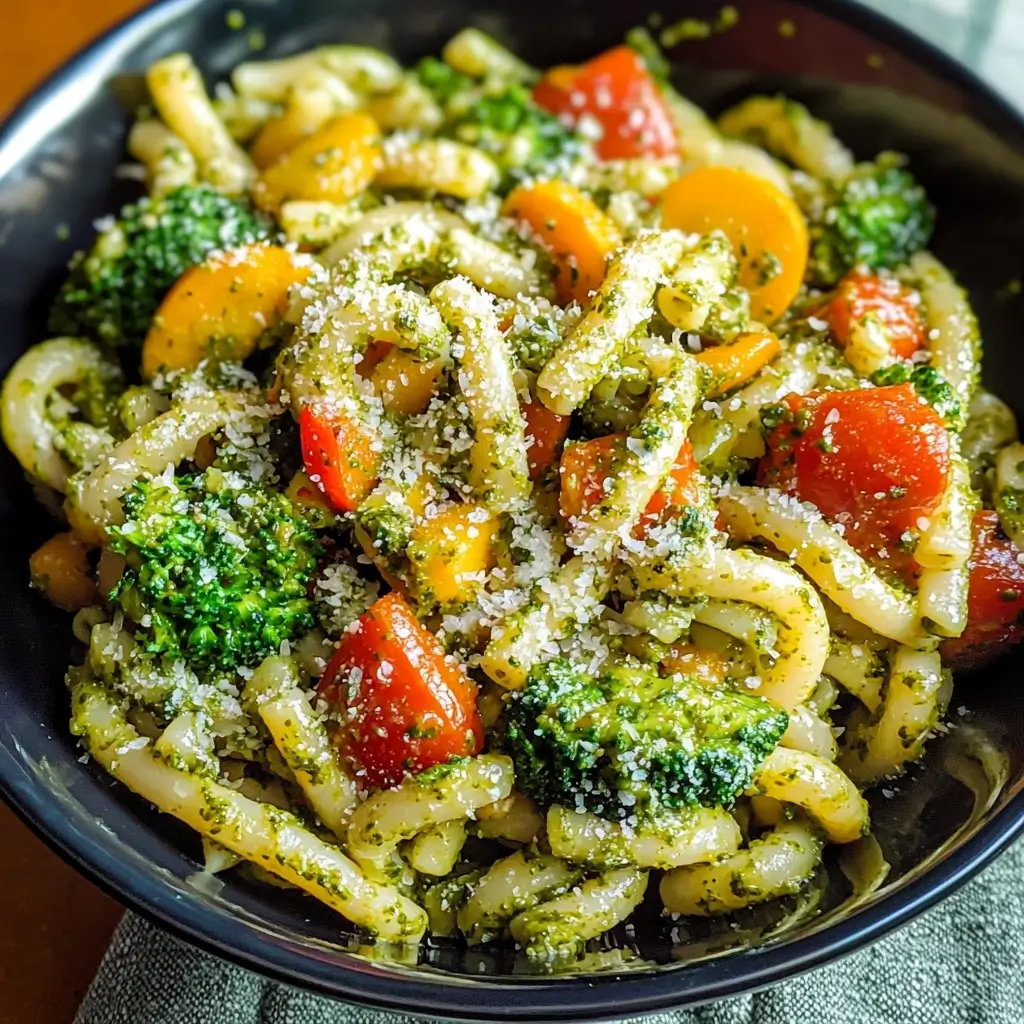This Creamy Pesto Veggie Pasta has become an absolute lifesaver in our household. I remember the first time I whipped it up; it was one of those chaotic weeknights where everyone was hungry, and I needed something quick, nutritious, and, most importantly, something everyone would actually eat. The vibrant green of the pesto, combined with the colorful medley of vegetables and the sheer creamy indulgence of the sauce, was an instant hit. Even my usually picky eater asked for seconds! It’s since become a staple, a go-to dish that feels a bit fancy but is deceptively simple to prepare. The beauty of it lies in its versatility – you can swap out veggies based on what’s in season or what you have on hand, and it still turns out incredibly delicious every single time. It’s the kind of meal that brings a little bit of sunshine to the dinner table, no matter the day.
Ingredients for Your Delicious Creamy Pesto Veggie Pasta
Here’s what you’ll need to create this comforting and flavorful dish:
- Pasta: 1 pound (450g) of your favorite short pasta (e.g., penne, fusilli, rotini, farfalle). Whole wheat or gluten-free varieties work wonderfully too.
- Olive Oil: 2 tablespoons, extra virgin. For sautéing the vegetables and adding richness.
- Onion: 1 medium, finely chopped. Yellow or white onions are perfect for building a savory base.
- Garlic: 3-4 cloves, minced. Fresh garlic is key for that aromatic punch.
- Bell Peppers: 2 medium, mixed colors (e.g., red, yellow, orange), sliced. They add sweetness, color, and a lovely crunch.
- Zucchini: 1 medium, diced or sliced into half-moons. Adds a tender bite and subtle sweetness.
- Broccoli Florets: 1 cup, small florets. For a boost of green and essential nutrients.
- Cherry Tomatoes: 1 cup, halved. They burst with sweetness and juiciness when cooked.
- Basil Pesto: ¾ cup, store-bought or homemade. The star of the sauce, providing herbaceous, nutty, and cheesy flavors.
- Heavy Cream or Coconut Cream: ½ cup. This is what makes the sauce luxuriously creamy. Use coconut cream for a dairy-free/vegan option.
- Cream Cheese: ¼ cup (2 oz), softened and cut into cubes (optional, for extra creaminess). Ensures an ultra-smooth and rich sauce. Can be omitted or use a vegan alternative.
- Vegetable Broth or Pasta Water: ½ cup, or as needed. To adjust the consistency of the sauce.
- Parmesan Cheese: ¼ cup, freshly grated, plus more for serving (optional). Adds a salty, umami depth. Use nutritional yeast for a vegan alternative.
- Salt: To taste. Enhances all the flavors.
- Black Pepper: Freshly ground, to taste. Adds a gentle warmth.
- Red Pepper Flakes: ¼ teaspoon (optional). For a little kick of heat.
- Fresh Basil Leaves: For garnish (optional). Adds a final touch of freshness and aroma.
Step-by-Step Instructions to Create Creamy Pesto Veggie Pasta
Follow these simple steps to pasta perfection:
- Cook the Pasta: Bring a large pot of salted water to a rolling boil. Add the pasta and cook according to package directions until al dente (tender but still slightly firm to the bite). Before draining, reserve about 1 cup of the starchy pasta water. Drain the pasta and set aside. Tossing it with a drizzle of olive oil can prevent sticking if it will sit for a while.
- Sauté the Aromatics: While the pasta is cooking, heat the 2 tablespoons of olive oil in a large skillet or Dutch oven over medium heat. Add the chopped onion and sauté for 3-4 minutes until softened and translucent.
- Add Harder Vegetables: Add the minced garlic, sliced bell peppers, and broccoli florets to the skillet. Cook for 5-7 minutes, stirring occasionally, until the vegetables are tender-crisp. You want them to retain some of their vibrant color and a slight bite.
- Add Softer Vegetables: Stir in the diced zucchini and halved cherry tomatoes. Cook for another 3-5 minutes, or until the zucchini is tender and the tomatoes begin to soften and release their juices. Season the vegetables with a pinch of salt and freshly ground black pepper.
- Create the Creamy Pesto Sauce: Reduce the heat to low. Add the basil pesto, heavy cream (or coconut cream), and cubed cream cheese (if using) to the skillet with the vegetables. Stir continuously until the cream cheese has melted and the sauce is smooth and well combined.
- Adjust Sauce Consistency: Gradually stir in the vegetable broth or reserved pasta water, a little at a time, until the sauce reaches your desired consistency. You might not need all of it. The starchy pasta water is particularly good for helping the sauce cling to the pasta.
- Combine with Pasta: Add the cooked pasta to the skillet with the creamy pesto vegetable sauce. Toss gently but thoroughly to ensure every piece of pasta is coated in the luscious sauce and the vegetables are evenly distributed.
- Stir in Cheese (Optional): If using, stir in the ¼ cup of grated Parmesan cheese (or nutritional yeast). Taste and adjust seasoning with more salt, pepper, or red pepper flakes if desired.
- Serve Immediately: Divide the creamy pesto veggie pasta among serving bowls. Garnish with extra grated Parmesan cheese, fresh basil leaves, and a sprinkle of red pepper flakes if you like. Enjoy hot!
Nutrition Facts (Estimated)
- Servings: 4-6 hearty servings
- Calories per serving (approximate, based on 6 servings): 550-650 kcal. This can vary significantly based on pasta type, specific pesto brand, and use of cream cheese.
- Rich in Vitamins: From the diverse range of vegetables, providing Vitamin A (from bell peppers), Vitamin C (from bell peppers, broccoli, tomatoes), and Vitamin K (from broccoli and pesto).
- Good Source of Fiber: Contributed by whole wheat pasta (if used) and the plentiful vegetables, aiding digestion and promoting satiety.
- Healthy Fats: Primarily from olive oil and pine nuts (in pesto), which are beneficial monounsaturated and polyunsaturated fats.
- Source of Protein: Pasta itself provides some protein, which can be boosted by using protein-enriched pasta or adding a protein source like grilled chicken or chickpeas.
Preparation Time for Your Creamy Pesto Delight
- Prep Time: Approximately 15-20 minutes (chopping vegetables, measuring ingredients).
- Cook Time: Approximately 20-25 minutes (cooking pasta, sautéing vegetables, making the sauce).
- Total Time: Approximately 35-45 minutes.
This dish is perfect for a weeknight meal, offering a gourmet experience without spending hours in the kitchen. The majority of the time is active cooking, but it comes together quite efficiently.
How to Serve This Delicious Creamy Pesto Veggie Pasta
This versatile dish can be served in various delightful ways to suit any occasion:
- As a Main Course:
- Serve hot, straight from the skillet, in generous individual bowls.
- Garnish generously with freshly grated Parmesan cheese (or nutritional yeast for a vegan option).
- A sprinkle of toasted pine nuts adds a delightful crunch and enhances the pesto flavor.
- A few fresh basil leaves on top provide a beautiful color contrast and fresh aroma.
- A drizzle of high-quality extra virgin olive oil just before serving can elevate the richness.
- With Protein Additions:
- Top with grilled chicken breast strips for a heartier meal.
- Serve alongside pan-seared shrimp or salmon.
- Mix in cooked chickpeas or white beans for a vegetarian protein boost.
- Crumble some cooked Italian sausage into the sauce for extra flavor.
- Accompaniments:
- Crusty Bread: Perfect for mopping up every last bit of that delicious creamy pesto sauce. Garlic bread or a simple baguette works wonders.
- Simple Green Salad: A light, crisp salad with a vinaigrette dressing offers a refreshing contrast to the richness of the pasta.
- Roasted Asparagus or Green Beans: If you want even more veggies on the side.
- For Different Occasions:
- Weeknight Dinner: Its quick preparation time makes it ideal for busy evenings.
- Lunchbox Meal: It reheats well, making it a great option for next-day lunches. Add a splash of water or broth when reheating to maintain creaminess.
- Potlucks and Gatherings: This dish is always a crowd-pleaser and can be easily scaled up. Serve it in a large chafing dish to keep warm.
- Date Night: The creamy texture and vibrant flavors make it feel special enough for a romantic dinner at home.
Additional Tips for the Perfect Creamy Pesto Veggie Pasta
Elevate your pasta game with these expert tips:
- The Magic of Pasta Water: Don’t underestimate the power of reserved pasta water! The starch in the water helps to emulsify the sauce, making it creamier and helping it cling beautifully to the pasta. Always reserve more than you think you’ll need.
- Al Dente is Key: Cook your pasta until it’s al dente – tender but with a slight bite. It will continue to cook a little more when combined with the hot sauce. Overcooked pasta can become mushy.
- Vegetable Variety & Prep: Feel free to customize the vegetables based on season or preference. Mushrooms, spinach, asparagus, peas, or sun-dried tomatoes are all excellent additions. Cut vegetables into similar-sized pieces for even cooking.
- Pesto Power: The quality of your pesto significantly impacts the final flavor. Use a good quality store-bought pesto or, even better, make your own fresh pesto if you have the time. If your pesto is very thick, you might need a bit more liquid to thin out the sauce.
- Achieving Ultimate Creaminess: For an extra decadent sauce, ensure your cream cheese is well-softened and cut into small cubes so it melts smoothly. If you’re avoiding cream cheese, a little extra heavy cream or a cornstarch slurry (1 tsp cornstarch mixed with 1 tbsp cold water) can help thicken the sauce.
- Boost the Protein: This dish is fantastic as is, but you can easily make it a more substantial meal by adding cooked chicken, shrimp, Italian sausage, chickpeas, or cannellini beans. Stir them in with the pasta and sauce.
- Spice it Up or Tone it Down: Adjust the amount of red pepper flakes to your liking. For a milder dish, omit them entirely. For a bolder flavor, consider adding a pinch of smoked paprika or a dash of your favorite hot sauce.
- Storage and Reheating: Store leftovers in an airtight container in the refrigerator for up to 3-4 days. To reheat, gently warm on the stovetop over low heat, adding a splash of water, broth, or milk to loosen the sauce and restore its creaminess. Microwaving works too, but stovetop reheating often yields better results for creamy pasta dishes.
Frequently Asked Questions (FAQ) about Creamy Pesto Veggie Pasta
Here are answers to some common questions about this delightful dish:
- Can I make this Creamy Pesto Veggie Pasta vegan?
Absolutely! To make it vegan, use a plant-based heavy cream alternative (like full-fat coconut cream or a soy/oat-based cream), ensure your pesto is dairy-free (many are, but check labels for Parmesan), use vegan cream cheese or omit it, and substitute nutritional yeast for Parmesan cheese for that cheesy, umami flavor. - How can I make this recipe gluten-free?
Simply use your favorite gluten-free pasta variety. Rice pasta, corn pasta, or lentil/chickpea-based pastas all work well. Cook according to package directions, as gluten-free pasta can sometimes cook differently than traditional wheat pasta. The rest of the ingredients are naturally gluten-free (but always double-check labels, especially for pesto and broth). - Is it better to use homemade or store-bought pesto?
Homemade pesto often has a fresher, more vibrant flavor if you have access to fresh basil and good quality ingredients. However, there are many excellent store-bought pestos available that make this dish incredibly convenient. If using store-bought, look for one with minimal ingredients and a good olive oil base. - What other vegetables can I use in this pasta?
This recipe is highly adaptable! Consider adding or substituting with:- Mushrooms (cremini, shiitake, or button)
- Spinach or kale (stir in at the end until wilted)
- Asparagus spears (blanched or sautéed)
- Green peas (fresh or frozen)
- Sun-dried tomatoes (oil-packed, drained)
- Artichoke hearts (canned or jarred, drained and quartered)
- Eggplant (diced and sautéed)
- Can I make this dish ahead of time?
While pasta dishes are generally best served fresh, you can prepare components ahead. Chop the vegetables a day in advance and store them in an airtight container. You can also cook the pasta just shy of al dente, drain, toss with a little olive oil, and store it. The sauce can be made ahead and gently reheated. Combine everything just before serving. If making the entire dish ahead, it might become a bit dry upon reheating; add a splash of broth, water, or cream to revive the sauce. - My pesto sauce sometimes separates or looks oily. How can I prevent this?
This can happen if the sauce gets too hot or if the pesto has a very high oil content. To prevent separation:- Add the pesto and cream components over low heat.
- Stir constantly until everything is just combined and heated through.
- Using reserved starchy pasta water helps emulsify the sauce, making it less likely to separate.
- Cream cheese also acts as a good stabilizer.
- How do I prevent my creamy pasta from becoming dry after a while or as leftovers?
Creamy pasta sauces can thicken considerably as they cool because the pasta absorbs liquid.- Ensure your sauce is quite luscious and a little “saucier” than you think it needs to be before serving.
- When reheating, always add a splash of liquid (water, broth, milk, or cream) to loosen the sauce and restore its creamy texture. Stir gently over low heat.
- Is this Creamy Pesto Veggie Pasta kid-friendly?
Yes, generally it is! The creamy texture and familiar pasta shape are usually appealing to children. The vibrant colors from the vegetables can also be enticing. If your children are sensitive to certain vegetables, you can dice them smaller or choose milder options like zucchini and peas. You can also adjust the amount of garlic or omit the red pepper flakes to suit their palates. Allowing them to choose some of the veggies can also increase their interest.






